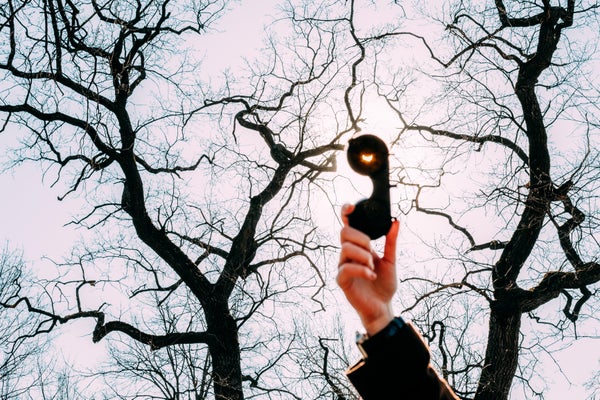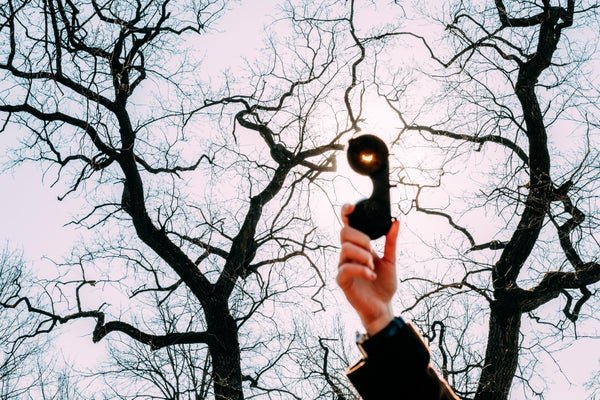Are Your Solar Eclipse Glasses Fake? Here’s How to Check
You’re going to want to guard your eyes from the sun using legitimate protective gear

Ryhor Bruyeu/Alamy Stock Photo
This article is part of a special report on the total solar eclipse that will be visible from parts of the U.S., Mexico and Canada on April 8, 2024.
A day after the American Astronomical Society (AAS) announced that there were no signs of unsafe eclipse glasses or other solar viewers on the market in early March, astronomer and science communicator Rick Fienberg received an alarming call.
Fienberg is project manager of the AAS Solar Eclipse Task Force, which is busy preparing for the total eclipse over North America on April 8. He’s the creator of a list of vetted solar filters and viewers that will protect wearers’ eyes as they watch the moon move in front of the sun. When a solar eclipse last crossed a major swath of the U.S. in 2017, Fienberg and his team spotted some counterfeit glasses entering the marketplace—imitations that distributors claimed were manufactured by vetted companies. Testing at accredited labs indicated that many counterfeits were actually safe to use, however. This led the task force to describe such eclipse glasses as “misleading” but not “dangerous” in a March 11 statement meant to reassure the public.
On supporting science journalism
If you’re enjoying this article, consider supporting our award-winning journalism by subscribing. By purchasing a subscription you are helping to ensure the future of impactful stories about the discoveries and ideas shaping our world today.
But then Fienberg’s phone rang. The caller was “a guy who had bought thousands of eclipse glasses from a distributor who had been on our list at one point,” Fienberg says. “Those glasses were not safe. They were no darker than ordinary sunglasses.” Legitimate eclipse glasses are at least 1,000 times darker than the darkest sunglasses you can buy.
Fienberg contacted Cangnan County Qiwei Craft, a Chinese factory that he knew manufactured safe glasses and had—in the past—sold them to the distributor in question. But this time, Fienberg says, factory representatives told him they hadn’t sold to that distributor in a long while. “That’s when we switched from being concerned about only counterfeits to being concerned about actual fakes,” Fienberg says.
The AAS does not have a confident estimate of how many fake or counterfeit glasses are for sale out there. And though Fienberg doesn’t think this is a widespread problem, the situation is an “iceberg kind of concern,” he says, because there are likely more examples than the ones he knows about. While counterfeit glasses may still be safe to use, completely fake glasses could put wearers in serious danger.
If you’re viewing the upcoming eclipse, there are specific indicators you can look for when evaluating products for safety—and ways to test glasses before you stare at the sun.
The standard for solar eclipse viewers
On April 8 viewers within a 115-mile-wide band stretching across Mexico and the U.S. into eastern Canada will experience a total solar eclipse: what happens when the moon passes directly between the sun and Earth, completely blocking the face of our star. Outside of this band, people in much of North America will be able to see a partial eclipse.
“It’s a beautiful alignment,” says Michelle Wooten, an assistant professor of astronomy education at the University of Alabama at Birmingham. But Wooten has observed that people are often careless when viewing eclipses—she says she has seen people look directly at the sun with no protection at all. According to NASA, the only safe time to observe a total eclipse without a solar viewer or filter is during the fleeting moments of totality, when the moon completely covers the sun and the lunar shadow falls on Earth—and as soon as even a bit of sun emerges, one should immediately stop looking. Totality lasts around 3.5 to 5.5 minutes. It is never safe to view a partial eclipse directly without a special eye guard.
This is where safe solar eclipse glasses or other viewers can help. Those that comply with the ultraviolet, visible and infrared light transmittance requirements have a designation: ISO 12312-2:2015, a safety standard adopted by the International Organization for Standardization (ISO) in 2015. ISO standards are determined by a nongovernmental body of experts. An ISO standard isn’t legally enforceable, but it’s meant to be a mark of assurance when manufacturers comply.
Hin Cheung, a clinical assistant professor at the Indiana University School of Optometry, recommends that eclipse chasers looking for glasses check out the AAS list of legitimate solar viewers. But because anyone can print the ISO number onto their viewers and claim those products are safe, Cheung points out that one can’t necessarily trust online sellers making that assertion without cross-referencing the AAS list. Meanwhile don’t believe any sellers who say their glasses are “NASA-approved.” The federal space agency doesn’t endorse commercial products.
“If you were to use a fake viewer that does not meet that [ISO] standard, then unsafe levels of solar radiation could enter your eye and cause damage,” Cheung says. “That damage could also cause permanent changes to your vision.” Even a brief peek at the sun can temporarily or permanently burn the macula, the part of the retina involved in seeing what’s directly in front of you. It’s also critical to check eclipse glasses for scratches or tears. To avoid eye injury, never look at the sun through a camera lens, telescope or other optical lens without a solar filter designed for such tools.
If you don’t have solar glasses, there are ways to safely enjoy the eclipse with indirect views. They include methods such as using a pasta colander as a pinhole projector, which Wooten recommends as an easy and fun option for projecting an image of the sun onto the ground or other surface.
How to test whether eclipse glasses are safe
While lab tests are the best way to determine whether glasses meet the ISO standard, Fienberg says there is a three-part test people can do at home if they’re concerned their eclipse viewers aren’t up to the task.
First, put your glasses on indoors and look around. The only things you should be able to see are very bright lights, such as a halogen bulb or a smartphone flashlight.
Then, if the glasses pass the indoor test, bring them outside—but don’t look at the sun just yet. Look around: it should be too dark to see distant hills, trees or even the ground.
If that second test is passed, keep the glasses on and quickly glance at the sun. You should comfortably see a bright, sharp-edged round disk. If your glasses pass all three tests, they are probably safe to wear. Still, Fienberg points out that it’s best to use them for only a few seconds every minute or so during the eclipse; this cautious approach is how they’re intended to be used. And if you don’t trust your glasses for April’s celestial event, you could try to find a reliable pair in the next two decades. “You only have to wait 20 years for another really good eclipse year in the [United] States,” Fienberg says.



